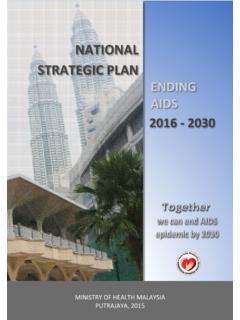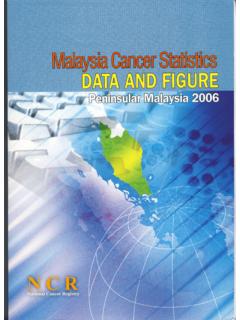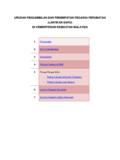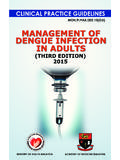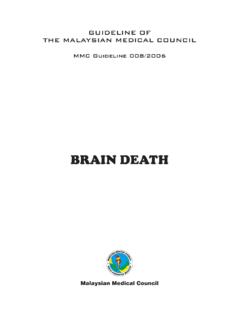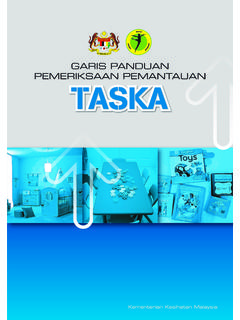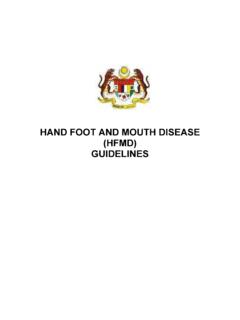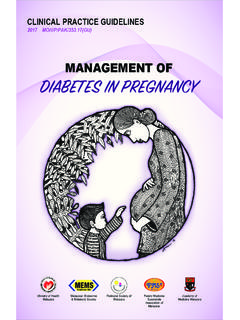Transcription of MANAGEMENT OF IMMUNE …
1 CLINICAL PRACTICE GUIDELINESMANAGEMENTOFIMMUNE THROMBOCYTOPENICPURPURAA ugust 2006 MOH/P/ (GU)MINISTRY OF HEALTH MALAYSIABERSATU BERUSAHA BERBAKTI ACADEMY OF MEDICINES tatement of IntentThis clinical practice guideline is meant to be a guide for clinicalpractice, based on the best available evidence at the time ofdevelopment. Adherence to these guidelines may not necessarilyensure the best outcome in every case. Every health care provideris responsible for the MANAGEMENT of his/her unique patient basedon the clinical picture presented by the patient and the managementoptions available of the GuidelinesThis guideline was issued in August 2006 and will be reviewed inAugust 2008 or sooner if new evidence becomes Secretariatc/o Health Technology Assessment UnitMedical Development DivisionMinistry of Health MalaysiaLevel 4, Block E1, Parcel E,Government Office Complex,62590, on the following website.
2 DEVELOPMENT AND OBJECTIVESG uideline DevelopmentThe development group for this guideline comprised of paediatricians,physicians, haematologists and an obstetrician from the Ministry of HealthMalaysia and Ministry of evidence search was carried out using Pubmed, Ovid and generalsearch engines with idiopathic thrombocytopenic purpura ; immunethrombocytopenic purpura ; platelet count ; autoimmune thrombocytopenicpurpura ; refractory thrombocytopenic purpura ; ITP; thrombocytopenia ANDtherapy as the key words. For paediatric AND pregnancy articles the previoussearch terms were combined with child and children and pregnancyrespectively. The search excluded secondary causes of ITP druginduced thrombocytopenia ; secondary IMMUNE thrombocytopenia . Related articles were selected and out of these, relevant articles werechosen and graded using the modified version of those used by the CataloniaAgency for Health Technology Assessment (CAHTA) guideline was also adapted from other international guidelines onManagement of Idiopathic thrombocytopenic purpura which includeGuidelines for the Investigation and MANAGEMENT of IdiopathicThrombocytopenic purpura in Adults, Children and in Pregnancy by BritishSociety for Haematology and Idiopathic thrombocytopenic purpura : Apractice guideline by American Society of Haematology.
3 This guideline isalso based on the findings of a systematic review of current medicalliterature, taking into consideration local practices. The draft guideline wasposted on both the Ministry of Health Malaysia and Academy of Medicine,Malaysia websites for comment and feedback. This guideline has also beenpresented to the Technical Advisory Committee for Clinical PracticeGuidelines and the Health Technology Assessment and Clinical PracticeGuidelines Council, Ministry of Health Malaysia for review and systematic approach to the treatment modalities was suggested dependingon the conditions associated with ITP. This is summarised as an algorithmof MANAGEMENT of ITP in adults, children and main aim of the guideline is to enable practitioners to make informedevidence based decisions on the diagnosis and MANAGEMENT of ImmuneThrombocytopenic purpura (primary or idiopathic).
4 Clinical QuestionsThe clinical questions of this guideline are:i)What is the clinical spectrum of IMMUNE thrombocytopenic purpura ?ii)How is IMMUNE thrombocytopenic purpura diagnosed?iii)How can patients with IMMUNE thrombocytopenic purpura be treatedoptimally?Target PopulationThis guideline is developed for the MANAGEMENT of patients with ImmuneThrombocytopenic purpura in children, adults and pregnant GroupThis guideline is applicable to all primary care providers, physicians,paediatricians, obstetricians and others involved in treating patients withImmune thrombocytopenic DEVELOPMENT GROUPCHAIRPERSONDr. Jameela SatharConsultant HaematologistHospital Thian LianDr. Sinari SallehConsultant PaediatricianConsultant HaematologistHospital Queen ElizabethHospital Sultanah AminahSabahJohor Bahru, JohorDr.
5 Goh Ai SimDr. Mahfuzah MohamedConsultant HaematologistPaediatric Haemato-OncologistHospital Pulau PinangPaediatric InstitutePulau PinangHospital Kuala LumpurDr. Ong Swee GaikDr Eeson SinthamoneyConsultant RheumatalogistObstetrician and GynaecologistHospital SelayangHospital AmpangSelangorSelangorDr Ho Lee MingAssoc Professor Hany AriffinPhysicianConsultant PaediatricianHospital Pakar Sultanah FatimahUniversity Malaya Medical CentreMuar, JohorKuala LumpurCOORDINATORSDr S SivalalDeputy DirectorHealth Technology Assessment UnitMedical Development DivisionMinistry of Health MalaysiaMr. Ganesan a/l ThankavelooSenior Medical AssistantHealth Technology Assessment UnitMedical Development DivisionMinistry of Health MalaysiaDr Sheamini SivasampuPrincipal Assistant DirectorHealth Technology Assessment UnitMedical Development DivisionMinistry of Health MalaysiaiiiSPECIALIST REVIEWERS (in alphabetical order)
6 The draft guideline was reviewed by a panel of independent expert referees,who were asked to comment primarily on the comprehensiveness and accuracyof interpretation of the evidence supporting the recommendations in the Abdul Rahman JamalSenior Consultant Paediatric Haematologist-OncologistHospital Universiti Kebangsaan MalaysiaDr Lin Hai PengSenior Consultant Paediatric Haematologist-OncologistSubang Jaya Medical CentreSelangorDr Chang Kian MengHead of Department and Consultant HaematologistDepartment of HematologyHospital Kuala LumpurDr Mukundan KrishnanHead of Department and Senior Consultant Obstretic And GynaecologistDepartment Obstretic & GynaecologyHospital IpohDr Ng Siew HianHead of Department and Senior Consultant AnaesthesiologistDepartment of AnaesthesiologyHospital Kuala LumpurDr V PurushothamanSenior Consultant HaematologistHospital Kuala LumpurDr Raman
7 SubramaniamSenior Consultant Obstretic And GynaecologistFetal Medicine & Gynaecology CentreKuala LumpurivTABLE OF CONTENTSG uideline Development And ObjectivesiClinical Practice Guidelines Development GroupiiiSpecialist IN of Chronic Line Line response to splenectomy6 Post operative complications6 Accessory Refractory of Helicobacter Dose antibody (Rituximab) IN of Acute of Chronic IN before 36 after 36 in labour205 NEONATAL Algorithm : ITP in Algorithm : ITP in Algorithm : ITP in STATEMENT34 SOURCES OF thrombocytopenic purpura (ITP) affects both children and adults. Itis an autoimmune disorder characterised by persistent thrombocytopenia(peripheral platelet count of less than 150 x109/L) due to autoantibody bindingto platelet antigen(s) causing their premature destruction by the reticulo-endothelial system, in particular the childhood, the peak age is 2-4 years, girls and boys are equally affected,and in most children the disease is self-limiting with spontaneous recoveryoccurring in several weeks to several months.
8 In adults, ITP is most commonamong young women and the disease is more insidious in its onset andchronic in its course 1 Level 9. The true incidence of ITP is still unknown. Inchildren, the overall incidence of ITP is 4 per 100,000 2 Level 8 ; 3 Level 6. Ithas been reported that the incidence of chronic adult ITP is around cases per 100,000 population per year in the USA 4 Level IN FeaturesIn adults, ITP typically has an insidious onset, with no prodromal and signs are highly variable, ranging from the commonasymptomatic patient with mild bruising or mucosal bleeding to frankhaemorrhage from any site, the most serious of which is most common manifestation in ITP is mucocutaneous bleeding withpurpura, epistaxis, gingival bleeding and menorrhagia.
9 Overall, bleedingsymptoms are uncommon unless the ITP is severe (platelet count < 30x109/l) 1 Level 9. The degree of bleeding is largely dependent on the platelet countand patients with platelet counts below 10x109/l (and usually below 5x109/l)are at greatest risk of bleeding, including intracranial is no gold standard diagnostic test to confirm ITP. The diagnosis ofITP remains clinical and is based principally on the exclusion of other causesof thrombocytopenia by the history, physical examination, full blood count,peripheral blood film and autoimmune can be defined as isolated thrombocytopenia with no clinically apparentassociated conditions or other causes of thrombocytopenia ( HIV1infection, systemic lupus erythematosus, lymphoproliferative disorders,myelodysplasia, drug-induced thrombocytopenia, congenital/hereditary non- IMMUNE thrombocytopenia, or pregnancy) 5 Level with isolated abnormalities on serologic tests ( positive testsfor antinuclear or antiphospholipid antibodies) but without a clinically evidentdisorder ( systemic lupus erythematosus) are included within thediagnosis of ITP 6 Level 8.
10 7 Level with thrombocytopenia and an associated clinically apparentautoimmune disease may have an illness comparable to ITP. Lists ofconditions which must be considered and excluded in the diagnosticevaluation of a patient with suspected ITP are as in Table 1: Differential DiagnosesFalsely low platelet countIn vitro platelet clumping caused by EDTA-dependent or cold-dependent causes of thrombocytopeniaPregnancy (gestational thrombocytopenia, preeclampsia)Drug-induced thrombocytopenia (common drugs include heparin,quinidine, quinine, and sulfonamides)Viral infections, HIV, infectious mononucleosis, hepatitisHypersplenism due to liver diseaseOther causes of thrombocytopenia that mimic ITPM yelodysplasiaCongenital thrombocytopenia eg. Wiskott-Aldrich syndrome, vonWillebrand disease type 2 BThrombotic thrombocytopenic purpura -Haemolytic uremicsyndromeChronic disseminated intravascular coagulationThrombocytopenia associated with other disordersAutoimmune diseases eg.

